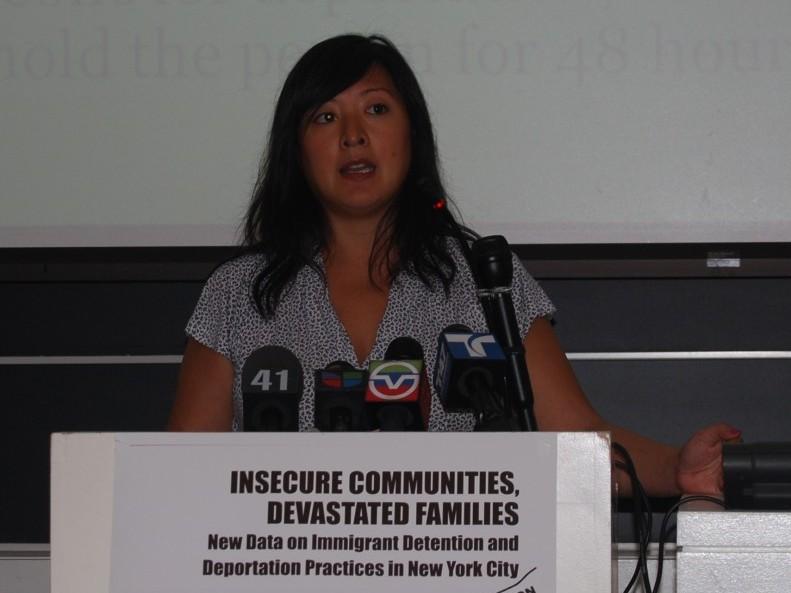NEW YORK—Almost 95 percent of detained noncitizen New Yorkers are deported, according to Immigration and Customs Enforcement (ICE) data released Monday.
The top three nationalities of those detained by the ICE are from Mexico, El Salvador, and Dominican Republic. The information was obtained via a Freedom of Information Act submission by the NYU Immigrant Rights Clinic.
Once apprehended, many of the illegal aliens in New York are sent to detention centers in remote locations in Texas and Louisiana, according to a report released Monday by the Immigrant Defense Project and Families for Freedom.
The number of transferred detainees has gone from 240 in 2005 to over 3,000 in 2010, and nearly 95 percent of the transferred New Yorkers end up deported.
Families for Freedom attributed this to the lack of access to legal assistance while the detainees are in remote detention centers.
Transferred Multiple Times
Dave Pierre was detained in 2010, when his immigration status came up after being stopped by a police officer for unrelated reasons, and has been transferred between facilities in Alabama, Louisiana, and Pennsylvania. He is now in York County, upstate New York.
“I was transferred here last year. ... I'd been transferred seven times in 25 days, back and forth,” Pierre said in a pre-recorded phone call with Families for Freedom. “I’ve been trying my case the whole 22 months I’ve been here, with no attorney.”
Pierre said the ICE has finally set a $100,000 bond for him, despite the judge ruling that he was not a flight risk or a “threat to the community.”
An individual arrested for state-law crimes in New York is eligible for a bail hearing to determine whether and how much a bond should be set at based on specifics to the case and individual.
According to the report, four out of five illegal aliens in New York are never given a bond setting; although 90 percent are eligible.
Michelle Fei, executive director of the Immigrant Defense Project, said that permanent residents (green-card holders) and students and workers on visas are often deported as well.
The criminal justice system for noncitizens has “unfortunately become one that justifies deporting anyone who has made a mistake or been accused of making a mistake,” Fei said. “Every single noncitizen can face deportation.”
Carl Rusnok, ICE spokesperson said in an email that the ICE prioritizes “removal of criminal aliens, recent border crossers, and egregious immigration law violators, such as those who have been previously removed from the United States or those with outstanding deportation orders.”
More than 390,000 deportations occurred in 2011.
ICE targets approximately 9 percent of the total nationwide deportations in 2012 to be from New York City, according to the data released Monday.
Secure Communities
Fei said programs like Secure Communities are what allow ICE to meet targets.
The Secure Communities program, which New York state joined in May, seeks to focus on targeting criminal aliens by partnering with local police precincts. Local precincts already share fingerprints with the FBI, and under Secure Communities the FBI will send the fingerprints to ICE as well. Non-citizens may be held for an additional two days while ICE determines whether the individual should be detained, focusing on repeat offenders of immigration law.
However, Fei said Secure Communities puts people into an “unfair and unjust” system regardless of whether they deserve to be deported or not.
“Our position is that all immigrants deserve a fair day in court,” Fei said. “Do we want people to be held accountable for their actions? Obviously, but we need that to happen through one system of justice that we can all play an equal part in.”
Alina Das, professor at the NYU Immigration Rights Clinic said the information from ICE was difficult to obtain. “The information we were seeking was rather straightforward: what happened to New Yorkers when they were caught up in the United States deportation and detention system? Of course, the information didn’t come easy,” Das said.
Das said the ICE told the organization it would be charged $1.3 million for the data. The students then filed a lawsuit and ICE agreed to release the data in a settlement.
The Epoch Times publishes in 35 countries and in 19 languages. Subscribe to our e-newsletter.







